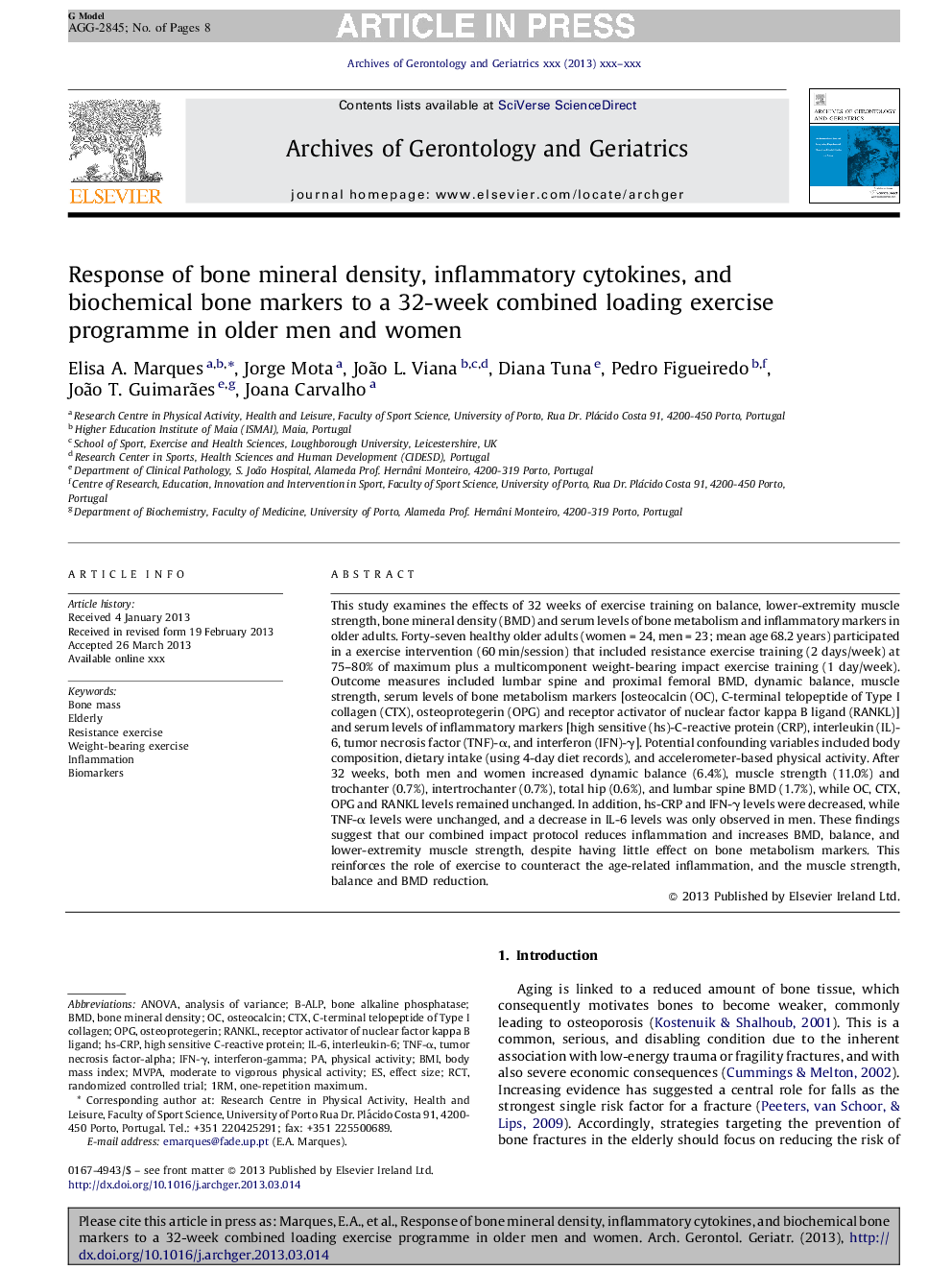| کد مقاله | کد نشریه | سال انتشار | مقاله انگلیسی | نسخه تمام متن |
|---|---|---|---|---|
| 8257979 | 1534441 | 2013 | 8 صفحه PDF | دانلود رایگان |
عنوان انگلیسی مقاله ISI
Response of bone mineral density, inflammatory cytokines, and biochemical bone markers to a 32-week combined loading exercise programme in older men and women
ترجمه فارسی عنوان
پاسخ تراکم معدنی استخوان، سیتوکین های التهابی و نشانگرهای بیوشیمیایی استخوان به برنامه تمرین بارگیری 32 هفته ای در مردان و زنان مسن
دانلود مقاله + سفارش ترجمه
دانلود مقاله ISI انگلیسی
رایگان برای ایرانیان
کلمات کلیدی
IFN-γone-repetition maximumWeight-bearing exercise1RMC-terminal telopeptide of type I collagenB-ALPOPGRCTMVPACTXhs-CRPBMDRANKLIL-6Randomized controlled trial - آزمایش تصادفی کنترل شدهBone alkaline phosphatase - آلکالین فسفاتاز استخوانOsteoprotegerin - استئوپروتگرینOsteocalcin - استئوکلسین inflammation - التهاب( توروم) Effect size - اندازه اثرinterferon-gamma - اینترفرون گاماinterleukin-6 - اینترلوکین ۶analysis of variance - تحلیل واریانسANOVA - تحلیل واریانس Analysis of varianceBone mineral density - تراکم معدنی استخوانResistance exercise - تمرین مقاومتیBone mass - توده استخوانیtumor necrosis factor-alpha - تومور نکروز عامل آلفاElderly - سالمندیbody mass index - شاخص توده بدنBMI - شاخص توده بدنیTNF-α - فاکتور نکروز توموری آلفاModerate to vigorous physical activity - فعالیت بدنی متوسط تا شدیدPhysical activity - فعالیت فیزیکیBiomarkers - نشانگر زیستی یا بیومارکرhigh sensitive C-reactive protein - پروتئین واکنش پذیر C با حساسیت بالاreceptor activator of nuclear factor kappa B ligand - گیرنده گیرنده لیگاند کاپا فاکتور هسته ای
موضوعات مرتبط
علوم زیستی و بیوفناوری
بیوشیمی، ژنتیک و زیست شناسی مولکولی
سالمندی
چکیده انگلیسی
This study examines the effects of 32 weeks of exercise training on balance, lower-extremity muscle strength, bone mineral density (BMD) and serum levels of bone metabolism and inflammatory markers in older adults. Forty-seven healthy older adults (women = 24, men = 23; mean age 68.2 years) participated in a exercise intervention (60 min/session) that included resistance exercise training (2 days/week) at 75-80% of maximum plus a multicomponent weight-bearing impact exercise training (1 day/week). Outcome measures included lumbar spine and proximal femoral BMD, dynamic balance, muscle strength, serum levels of bone metabolism markers [osteocalcin (OC), C-terminal telopeptide of Type I collagen (CTX), osteoprotegerin (OPG) and receptor activator of nuclear factor kappa B ligand (RANKL)] and serum levels of inflammatory markers [high sensitive (hs)-C-reactive protein (CRP), interleukin (IL)-6, tumor necrosis factor (TNF)-α, and interferon (IFN)-γ]. Potential confounding variables included body composition, dietary intake (using 4-day diet records), and accelerometer-based physical activity. After 32 weeks, both men and women increased dynamic balance (6.4%), muscle strength (11.0%) and trochanter (0.7%), intertrochanter (0.7%), total hip (0.6%), and lumbar spine BMD (1.7%), while OC, CTX, OPG and RANKL levels remained unchanged. In addition, hs-CRP and IFN-γ levels were decreased, while TNF-α levels were unchanged, and a decrease in IL-6 levels was only observed in men. These findings suggest that our combined impact protocol reduces inflammation and increases BMD, balance, and lower-extremity muscle strength, despite having little effect on bone metabolism markers. This reinforces the role of exercise to counteract the age-related inflammation, and the muscle strength, balance and BMD reduction.
ناشر
Database: Elsevier - ScienceDirect (ساینس دایرکت)
Journal: Archives of Gerontology and Geriatrics - Volume 57, Issue 2, SeptemberâOctober 2013, Pages 226-233
Journal: Archives of Gerontology and Geriatrics - Volume 57, Issue 2, SeptemberâOctober 2013, Pages 226-233
نویسندگان
Elisa A. Marques, Jorge Mota, João L. Viana, Diana Tuna, Pedro Figueiredo, João T. Guimarães, Joana Carvalho,
